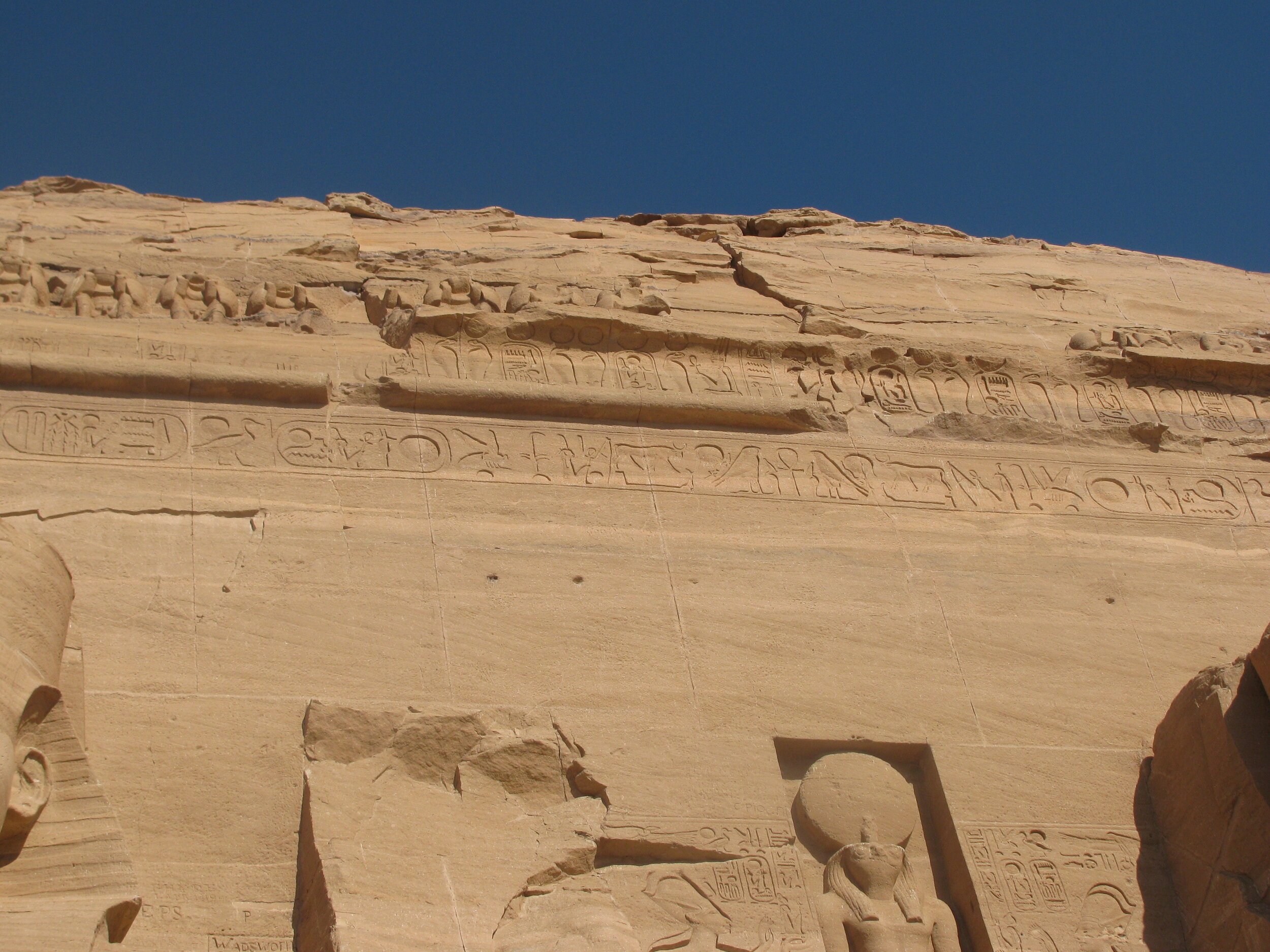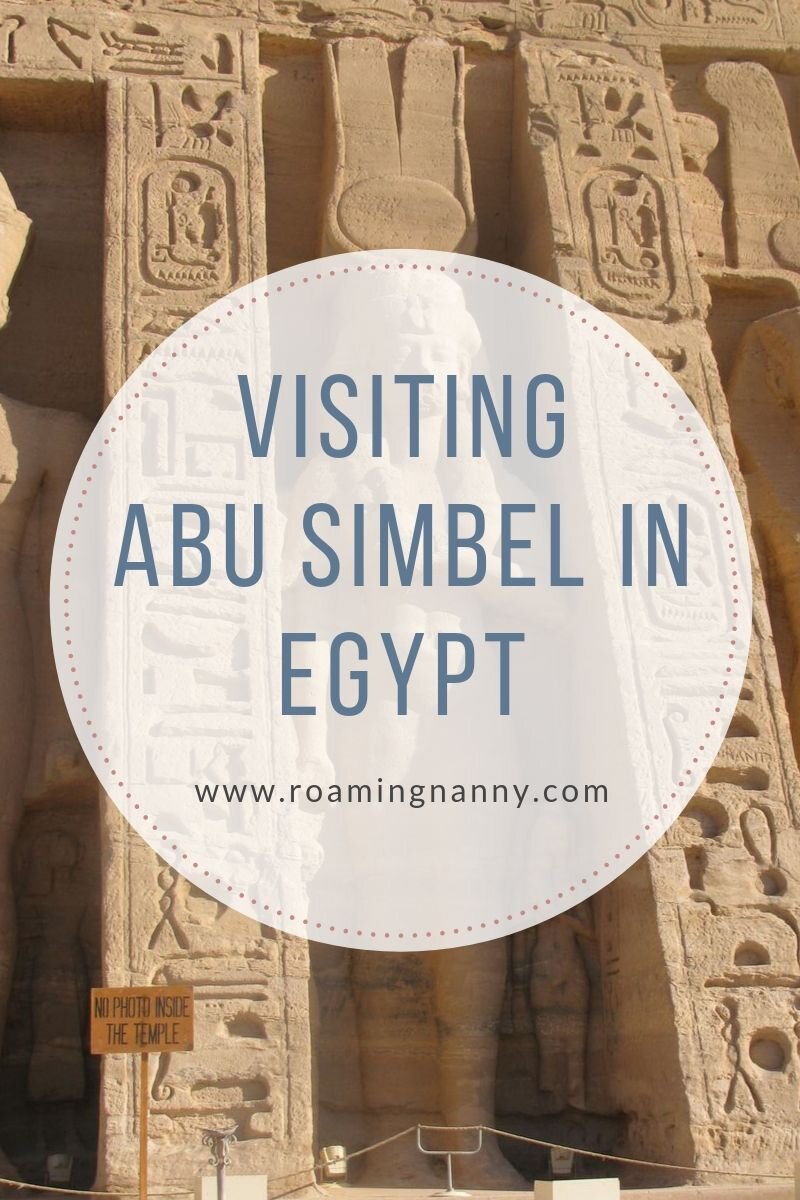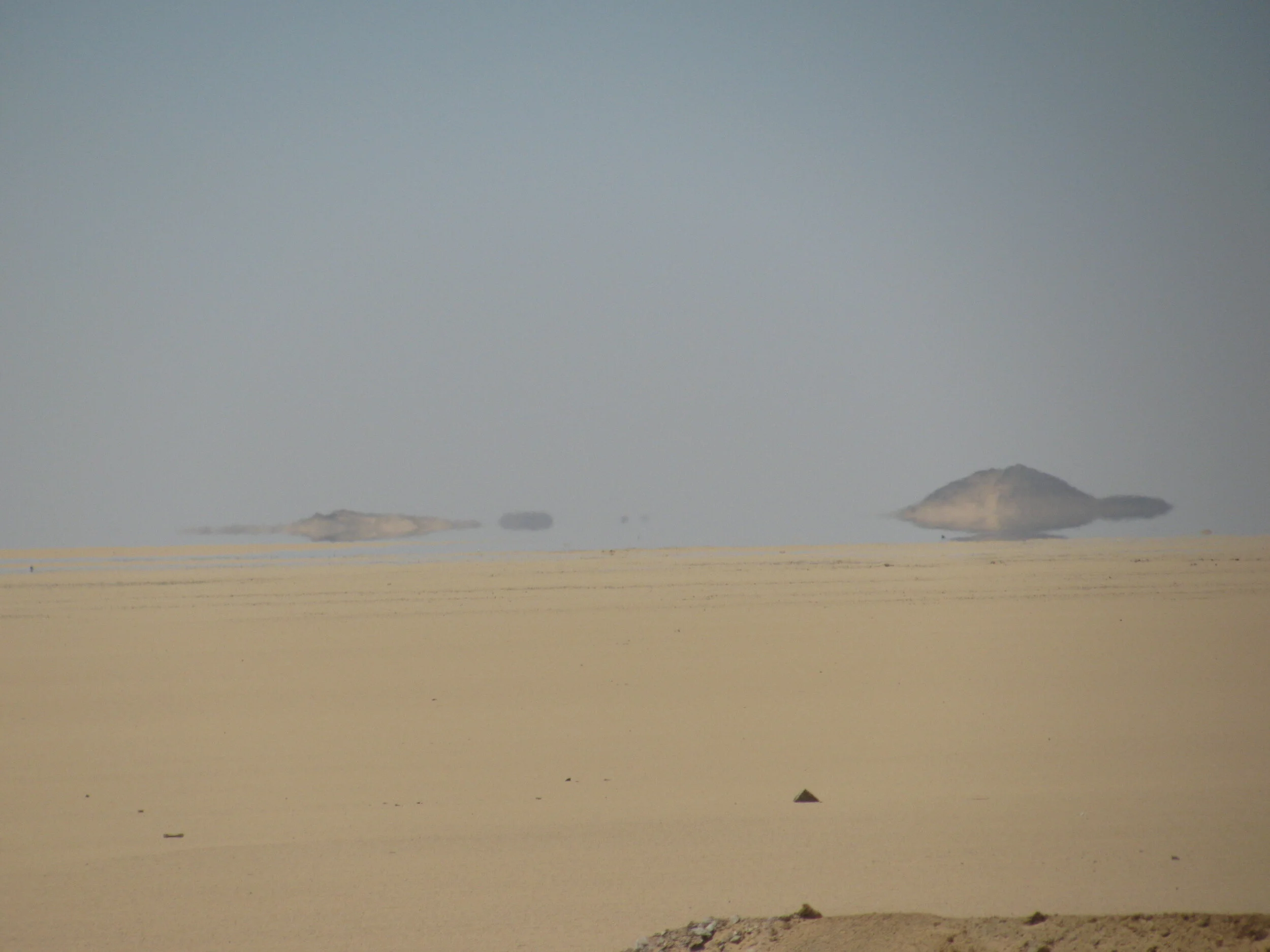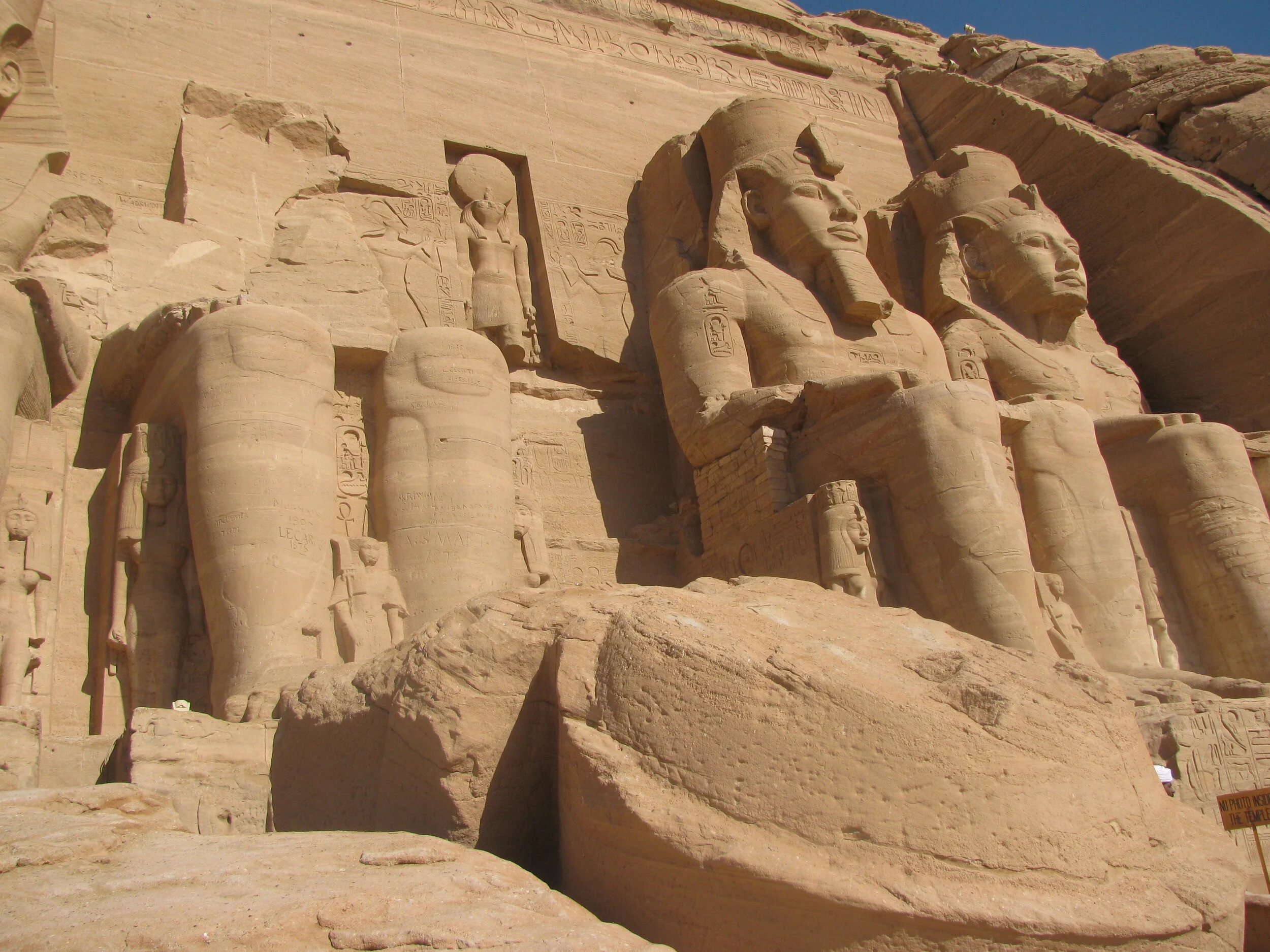The Temples of Abu Simbel are often overlooked by travelers for the more popular Pyramids of Giza, but it is considered one of the most beautiful places in Egypt. To be completely honest, I never heard of it until we were going over the itinerary and it was on there. The Abu Simbel temples are two massive rock temples, and I consider this complex one of the best temples in Egypt.
Temples of Abu Simbel
Guest Post written by Pam from Directionally Challenged Traveler
History and fact about Abu Simbel
The temples of Abu Simbel, located in southern Egypt near Sudan, were built in the 13th Century as a lasting monument to the king, Pharaoh Ramesses II, and his queen Nefertari. The temples also commemorate his victory at the battle of Kadesh in 1274 BCE. Ramesses chose the site near the Sudanese border because it was already sacred to Hathor, the goddess of motherhood, joy, and love. This act only strengthened his divinity in the eyes of his people.

Construction of the temple was completed around 1244 BC, but over time, the temples fell into disuse. Sand, ever-present in Egypt, began to cover the temple and by the 6th century BC the statues were covered to their knees.
It wasn’t until 1813 when Jean-Louis Burckhardt, a Swiss orientalist, found the top of the temple. Legend has it, he was guided to it by a boy named Abu Simbel, and so named it after him. Burckhardt discussed his findings with Italian explorer Giovanni Belzoni who was able to finally enter the complex in 1817. It has been admired by anthropologists, historians, and tourists alike ever since.
Getting to the Temples of Abu Simbel
To get to the temples of Abu Simbel, you can either fly or travel by bus from Aswan. Since you need to be a licensed operator to get through security checkpoints, you can’t simply rent a car and do the drive yourself. Our bus left bright and early at 3:30 am and was a three-hour drive to the temple. It’s a boring ride with deserts all around, be sure to bring a travel pillow and download our favorite Netflix shows to your device for the bus ride. However, if it’s going to be a particularly hot day, you may get lucky and see a mirage.
Love it? Pin It!

Food for thought: The definition of a mirage is an optical illusion caused by atmospheric conditions or something that appears real or possible but is not in fact so. If a mirage is a trick of the eye, how did I catch it on camera? 😉

Upon arrival at Abu Simbel, you’ll see the back of the temple first and the water of the Nile ahead of you. Once you round the bend, you can’t miss the four colossal statues, towering at over 65 feet (20m), representing Ramesses II, at different ages, seated on a throne.
The statues at the temples of Abu Simbel are not the same but depict Ramesses II throughout his life. The one on the immediate left of the entrance was damaged in an earthquake and rather than restoring them during the relocation, they were placed at the feet in the positions originally found. Beneath these massive figures are smaller statues (still larger than life-sized) depicting Ramesses’ enemies – the Nubians, Libyans, and Hittites.
Fun Fact: Guides are not allowed in the temple. This helps prevent tours from clogging up the entranceway. Guides will give you the history outside of the temple and tell you to keep an eye out for some things inside.
Relocating Abu Simbel
While the temple survived through ancient times and the trials of mother nature, it was threatened by modern progress in the 1960’s. When the decision to create the Aswan High Dam was made in the early 1960’s, researchers realized the temples would be flooded.
The entire complex was relocated in 1968 to prevent the temple from being submerged during the creation of Lake Nasser. Lake Nasser is the massive water reservoir that was formed after building the Aswan High Dam on the Nile. The temples were dismantled and relocated about 200 feet (64m) above and 600 feet (180m) west of their original site. You can still see where the temple was made into blocks to be moved if you look closely.

Moving the complex has gone down as one of history’s greatest archeological engineering challenges. You have to look very closely at the rocks to see how they were taken apart and reassembled – it’s nearly perfect.
Visiting the Temples of Abu Simbel
Everywhere you look at Abu Simbel, there is something grandiose. It was difficult to wrap my head around the ability to create these temples with such detail without the technology that we have today.
Fortunately, they have recently (as of 2019) started to allow people to take photos within the temple. You have to pay 300 Egyptian pounds for a ticket to do so though. One of my top tips for visiting Egypt is to carry small bills, but temples are a great place to break larger bills into smaller ones.
The ticket can be split within a couple you just have to take photos one at a time, otherwise, the guards will yell at you. Unfortunately for me, I went during a time that photos were not allowed at all. (I guess this means I’ll have to go back, right?)
Once you pass through the entrance, there are engravings showing Ramesses and Nefertari paying homage to the gods. On the north wall is a detailed story of the victory at Kadesh.
The smaller temple nearby has six colossi in the front façade – four which are the king, two are Queen Nefertari. This is a unique ode to the queen, typically women are represented on a much smaller scale than the Pharaoh. Nerfertari’s tomb is not in Abu Simbel, but rather in the Valley of the Queens.

Today, the temples of Abu Simbel are the most visited ancient sites in Egypt after the Great Pyramids of Giza, and for good reason. I was truly impressed with not only the size but the engineering that went into the temple – both when it was built and when it was moved – as well. Stepping into the temple is like stepping back in time. While you’re there, put the camera down, lift your head up, and embrace ancient Egypt and all its glory.
About the Author
I fell in love with getting wonderfully lost all over the world and it’s brought me to 35 countries and 7 continents so far.
The Directionally Challenged Traveler features the good and bad of travel – focusing on the beauty the world has to offer. Since the world is such an amazing place, there are no models or photo editing used, just real travel.
Have you been to the Temples of Abu Simbel? Let me know in the comments.
Love it? Pin it!




I don’t even know how I ended up here, but I thought this post was good.
I do not know who you are but definitely you are
going to a famous blogger if you aren’t already 😉 Cheers!
Thank you for the compliment.